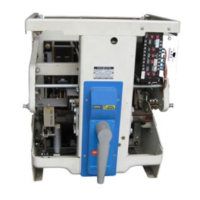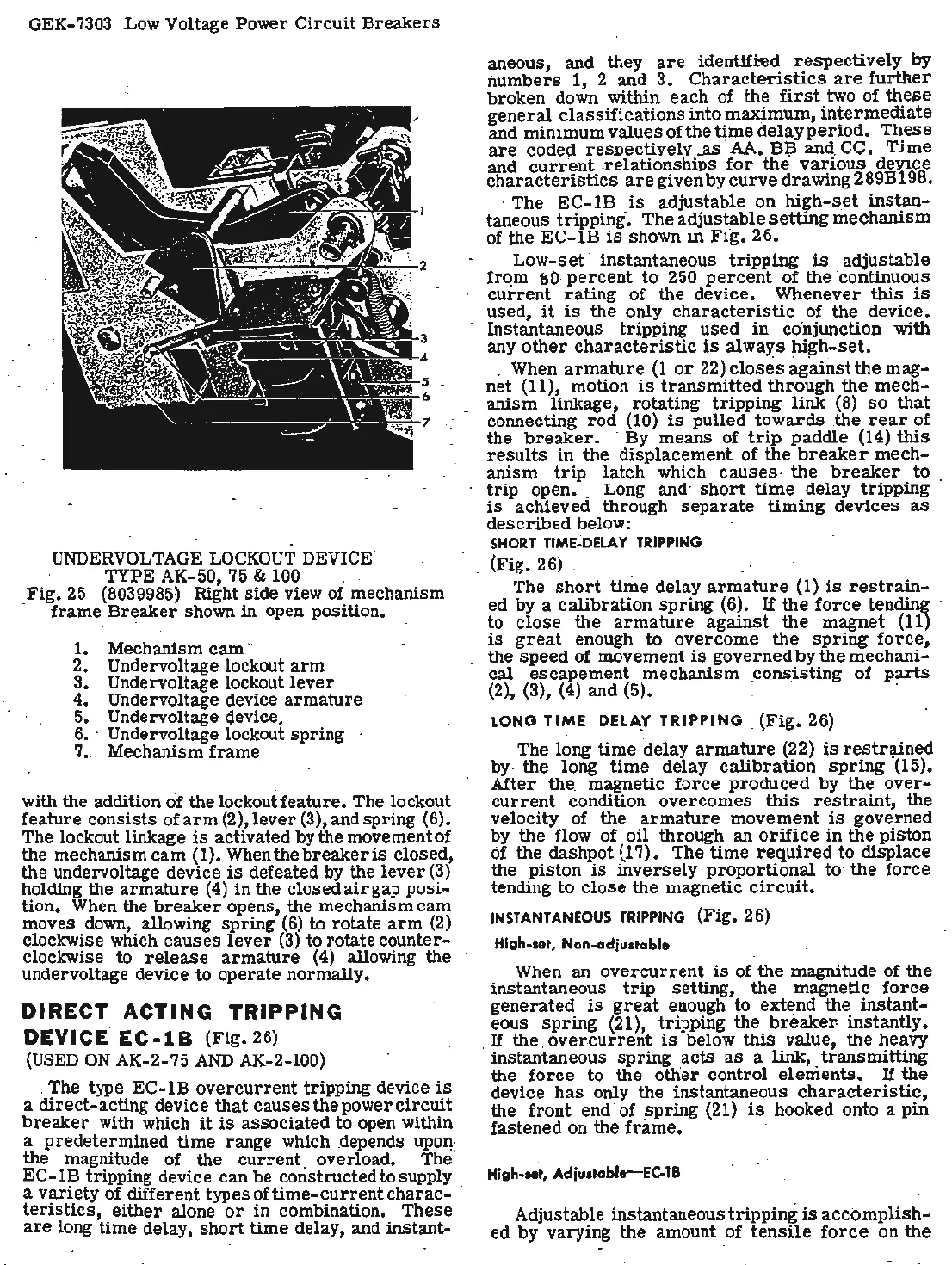GEK-7303 Low Voltage Power
Circuit
Breakers
UNDERVOLTAGE
LOCKOUT
DEVICE.
3
4
5
6
7
· · TYPE AK-50,
75
& 100 . . .
Fig.
25
(8039985) .Right
side
view of mechanism
-
frame
Breaker
shown in open position.
1. Mechanism cam
··
2. Undervoltage lockout
arm
3. Undervoltage lockout
lever
4. Undervoltage device
armature
5. Undervoltage cjevice.
6.
· Undervoltage lockout
spring
7 •. Mechanism
frame
with the addition of the lockoutfeature. The lockout
feature
consists
of
arm
(2),
lever
(3), and spring (6).
The lockout linkage
is
activated by the movement of
the mechanism cam (1). When the
breaker
is
closed,
the undervoltage device
is
defeated by the
lever
(3)
holding the
armature
(4)
in the
closedairgap
posi-
tion. When the
breaker
opens, the mechanism cam
moves down, allowing spring
(6)
to rotate
arm
(2)
clockwise which
causes
lever
(3)
to rotate counter-
clockwise to
release
armature
(4)
allowing the
undervoltage device to
operate
normally.
DIRECT
ACTING
TRIPPING
DEVICE
EC-1
B (Fig.
26)
(USED
ON
AK-2-75
AND
AK-2-100)
. The type
EC-lB
overcurrent
tripping device
is
a direct-acting device
that
causes
the power
circuit
breaker
with which
it
is
associated to open within
a
predetermined
time range which .depends upoq:
the magnitude . of the
current
overload. The
EC-lB
tripping device can be constructed to s·upply
a
variety
of different types of
time-current
charac-
·
teristics,
either
alone
or
in combination.
These
are
long
time
delay,
short
time
delay, and instant-
aneous, and they
are
identifred
respectively
by
numbers
1, 2 and
3.
Characte1'istics
are
further
broken
down within
each
of
the
first
two of
these
general
classifications
into maximum,
intermediate
and minimum
values
of the
time
delay
period.
These
are
coded resDectivelv
..as
· AA.
Bl,3
and. CC.
Tjme
and
current
.
relationships
for
the
various
device
characteristics
are
given by
curve
drawing
2 89B 198.
·
The
EC-
ll:3
is
adjustable
on
high-s
_
et
instan-
taneous
tripping.
The
adjustable
setting
mechanism
of the
EC-lB
is
shown
in
Fig.
26.
Low-set
· instan~aneous
tripping
is
adjustable
Irqm
bO
·
percent
to
250
percent
of
the
·continuous
current
rating
of the device. ·
Whenever
this
is
used,
it
is
the
only
characteristic
of the device.
Instantaneous tripping
used
in
conjunction with
any
other
characteristic
is
always
high-set.
. When
armature
(1
or
22)
closes
ag.ainstthe
mag-
·
net (11), motion
is
transmitted
through
the
mech-
·
anism linkage, rotating
tripping
link
(8)
so
that
connecting
rod
(10)
is
pulled
towards
..
the
rear
of
the
breaker.
· By
means
of
trip
paddle
(14)
this
results
in
the displacement of
the
breaker
mech-
anism
trip
·
latch
which
causes
-
the
breaker
to
trip
open • . Long and·
short
time
delay trippi!lg
is
achieved through
separate
timing
devices
as
described
below:
SHORT
TIME~DELA
Y
TRIPPING
. (Fig. 26) .
The
short
time
delay
armature
(1)
is
restrain-
ed
by a
calibration
spring
(6).
If
the
force
tending ·
to
close
the
armature
against
the
magnet
(11)
is
great
enough
to
overcome
the
spring
force,
_ the
speed
of movement
is
governed
by
the
mechani-
cal
escapement
mechanism
_cons_
isting
of
parts
(2>,
(3),
(4)
and (5). . · .
LONG
TIME
DELAY .
TRIPPING
.
(Fig.
26)
The long
time
delay
armature
(22)
is
restr:µned
by- the long
time
delay
calibration
spring
(15).
After
the. magnetic
force
produced
by
the
over-
current
condition
overcomes
this
restraint,
.the
velocity of the
armature
movement
is
governed
by the flow of
oil
through an
orifice
in the
piston
6f the dashpot (17).
The
time
required
to displace
the
piston
is
inversely
proportional
to·
the
force
tending to
close
the magnetic
circuit
.
INSTANTANEOUS
TRIPPING
(Fig. 26)
High-set, Non-adjustable
When
an
overcurrent
is
of
the
magnitude of
the
instantaneous
trip
setting, the magnetic
force
generated
is
great
enough to extend the
instant-
eous
spring
(21), tripping the breaker-
instantly.
.
If
the.
overcurrent
is
below
this
. value,
the
heavy
instantaneous ·
spring
acts
as
· a
link,
transmitting
the
force
to the
other
control
elements.
·
If
the
device
has
only the instantaneous
characteristic,
the
front
end· of ~pring
(21)
is
hooked onto a
pin
fastened on the
frame.
·
. .
High-aet, Adjustable-EC-1B
Adjustable instantaneous
tripping
is
accomplish-
ed by
varying
the amount of
tensile
force
on
the

